
Hartschiere [1] (singular form: Hartschier) were predominantly members of the Bavarian residence guards before 1918, a historic military branch of the former Duchy and the later Electorate and at last Kingdom of Bavaria.

Hartschiere [1] (singular form: Hartschier) were predominantly members of the Bavarian residence guards before 1918, a historic military branch of the former Duchy and the later Electorate and at last Kingdom of Bavaria.
According to Meyers Konversations-Lexikon, the Germanized word Hartschier originally derived from the Italian word arciere for archer, [2] but it might also be possible that it has Spanish roots, because the Bavarian Duke William IV received a Spanish archer company (Spanish : arqueros) of Charles I of Spain and added Bavarian court bodyguards with notable roots in the deep Middle Ages. On April 13, 1669, Ferdinand Maria transformed this unit to the Hartschier-Garde. [3] The name of the former Austrian equivalent, the k.k. Arcièren-Leibgarde, is similar-sounding.
The Bavarian palace guard troop, later called Königlich-Bayerische Leibgarde der Hartschier (L.G.H.), [4] had only ceremonial and no conventional military functions. Relating to military affairs, the Command of the Leibgarde der Hartschiere was directly subordinated to the Army Ministry. By contrast the Leibgarde der Hartschiere by itself was subordinated, concerning civilian and criminal justiciable affairs, to the General Command in Munich like the other military branches. [5] In addition to the Hartschiere, the kings of Bavaria had a royal house regiment from the end of the Napoleonic Wars until the fall of the kingdom after World War I, the so-called Infantry Lifeguards Regiment.
Entrance to this Guard was only possible for soldiers of impeccable character and conduct. The commander of the Hartschier troop had the title Generalkapitän (see also Captain General), associated with the highest class ranking in the Hofrangordnung (court order of precedence). [6] He was appointed personally by the king. [7]

In 1852 the Hartschiere got new uniforms with white supra vests over their jackets and helmets instead of the former caps, made of nickeled tin and gilded cast brass. The golden helmet plate showed the royal coats of arms and on top of the helmet was a standing golden lion figure. [8] The helmet was worn with the lion for normal service, which was replaced by a white horsehair plume on full dress occasions. [7] Older helmets had obviously two-headed eagle figures on top instead of the lion. [9] [ verification needed ] The embroidered patch on the chest of the Hartschiere showed a large version of the Order of Saint Hubertus (Hubertusorden) with its motto "in trau vast" (means: be firm in fidelity). The Hartschiere were armed with épées and the halberd-like "couse". [3]
On the occasion of the 200th anniversary a commemorative medal (2 Ducats) with a portrait of Ludwig II of Bavaria was given out in 1869. [10]

Ludwig III was the last King of Bavaria, reigning from 1913 to 1918. Initially, he served in the Bavarian military as a lieutenant and went on to hold the rank of Oberleutnant during the Austro-Prussian War. He entered politics at the age of 18 becoming a member of the Bavarian parliament and was a keen participant in politics, supporting electoral reforms. Later in life, he served as regent and de facto head of state from 1912 to 1913, ruling for his cousin, Otto. After the Bavarian parliament passed a law allowing him to do so, Ludwig deposed Otto and assumed the throne for himself. He led Bavaria during World War I. His short reign was seen as championing conservative causes and he was influenced by the Catholic encyclical Rerum novarum.
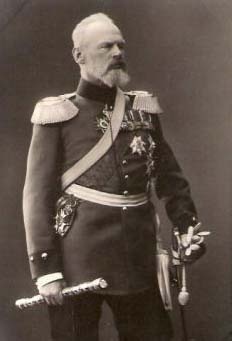
Prince Leopold of Bavaria was born in Munich, the second son of Prince Regent Luitpold of Bavaria (1821–1912) and his wife Archduchess Augusta of Austria (1825–1864). He was a Field Marshal (Generalfeldmarschall) who commanded German and Austro-Hungarian forces on the Eastern Front in World War I.
The 25th Division, officially the Grand Ducal Hessian (25th) Division, was a unit of the Prussian/German Army. It was headquartered in Darmstadt, the capital of the Grand Duchy of Hesse. The division was subordinated in peacetime to XVIII Army Corps when that corps was formed in 1899. The division was disbanded in 1919, during the demobilization of the German Army after World War I.

Felix Ludwig Grafvon Bothmer was a German general from Bavaria. He notably served in the Brusilov offensive of World War I.
This is the German Army order of battle on the outbreak of World War I in August 1914.
The Royal Bavarian Life Guards was a household, life guard (bodyguard) regiment of the Bavarian kings from the end of the Napoleonic Wars until the fall of the Wittelsbach monarchy and the subsequent disbanding of the Bavarian army.
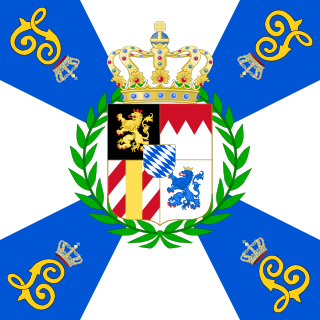
The Bavarian Army was the army of the Electorate (1682–1806) and then Kingdom (1806–1918) of Bavaria. It existed from 1682 as the standing army of Bavaria until the merger of the military sovereignty of Bavaria into that of the German State in 1919. The Bavarian Army was never comparable to the armies of the Great Powers of the 19th century, but it did provide the Wittelsbach dynasty with sufficient scope of action, in the context of effective alliance politics, to transform Bavaria from a territorially-disjointed small state to the second-largest state of the German Empire after Prussia.

Leonhard Freiherrvon Hohenhausen und Hochhaus was a Bavarian military and Acting War Minister from 1 March 1847 to 1 February 1848. His last military rank was General der Kavallerie.

Joseph Maximilian Fridolin Rittervon Maillinger was a Bavarian General der Infanterie and War Minister under Ludwig II of Bavaria.
The Chief of the General Staff of the Bavarian army was the military leader of the armed forces in the Kingdom of Bavaria.
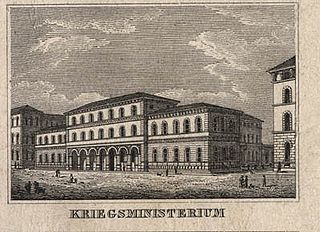
The Ministry of War was a ministry for military affairs of the Kingdom of Bavaria, founded as Ministerium des Kriegswesens on October 1, 1808 by King Maximilian I Joseph of Bavaria. It was located on the Ludwigstraße in Munich. Today the building, which was built by Leo von Klenze between 1824 and 1830, houses the Bavarian public record office, Bayerisches Hauptstaatsarchiv und Staatsarchiv München.
Maximilian "Max" GrafSeyssel d'Aix was a Bavarian Lieutenant General.
Maximilian Grafvon Verri della Bosia genannt von Külberg auf Gansheim und Berg was a Bavarian general.
Christian Marianne Wilhelm August Franz Freiherrvon Zweibrücken, before 1792 Graf von Forbach, was a Bavarian General der Kavallerie, and later Generalkapitän of the Leibgarde der Hartschiere. He may not be confused with his uncle Christian Freiherr von Zweibrücken, who was a Bavarian General der Infanterie.
Friedrich Joseph of Nauendorf, a general in Habsburg service during the French Revolutionary Wars, was noted for his intrepid and daring cavalry raids. Like most Austrian officers of the French Revolutionary Wars, he joined the military as a young man, and served in the War of Bavarian Succession. In the war's opening action, he successfully repelled a Prussian border raid, which earned him the admiration of the Empress Maria Theresa's son, Joseph. His continued success in the Habsburg border wars with the Ottoman Empire added to his reputation as a commander.
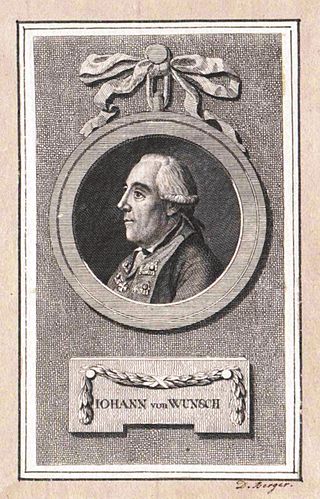
Johann Jakob von Wunsch (1717–1788) was soldier of fortune and Prussian general of infantry, and a particularly adept commander of light infantry. The son of a Württemberg furrier, he served in several armies in the course of his lengthy career.

A trabant was a historical name for an attendant or a lifeguard, especially in the Middle Ages, who usually travelled on foot. The role of a trabant was to protect a member of the aristocracy, a senior official or a senior Landsknecht officer, or to carry out their orders. For a long time it was customary for them to dress in short white hose and a waistcoat in the Spanish style. In earlier times they were armed with a halberd and a dagger. Later they were also used as cavalry.
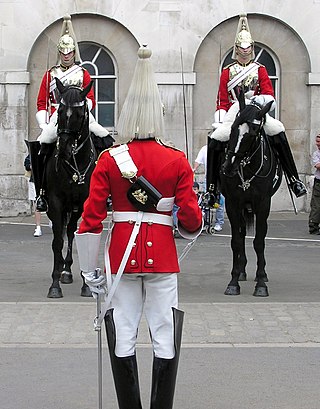
A life guard is a military unit charged with protecting a high-ranking individual, such as a monarch.

Felix Stieve was a German historian. He was the father of anatomist Hermann Stieve (1886–1952).
The military ranks of the German Empire were the ranks used by the military of the German Empire. It inherited the various traditions and military ranks of its constituent states.